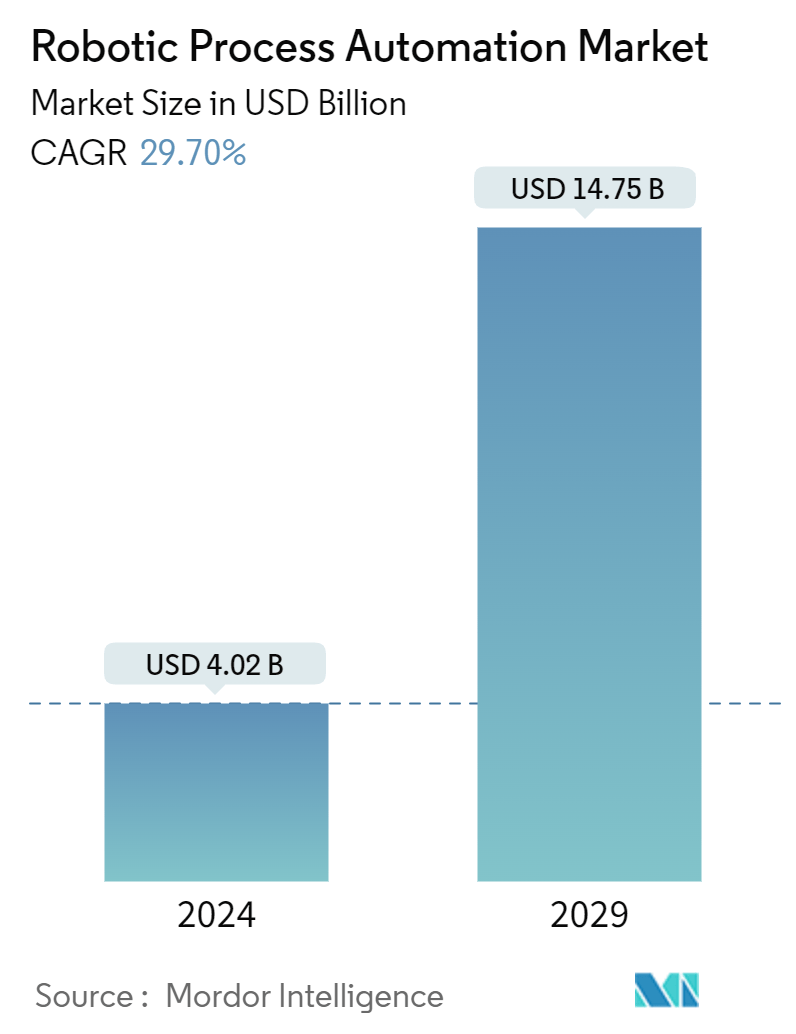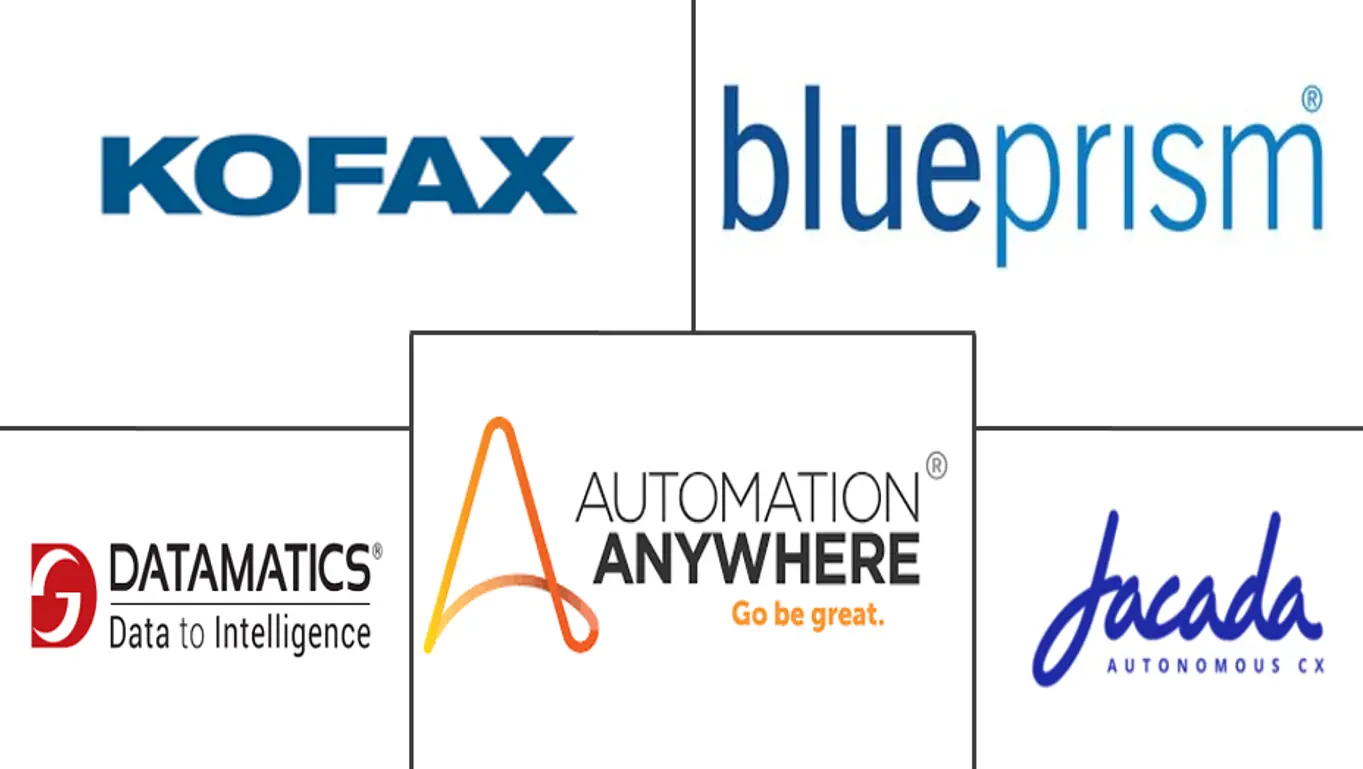Market Size of Robotic Process Automation Industry

| Study Period | 2021 - 2029 |
| Market Size (2024) | USD 4.02 Billion |
| Market Size (2029) | USD 14.75 Billion |
| CAGR (2024 - 2029) | 29.70 % |
| Fastest Growing Market | Asia Pacific |
| Largest Market | North America |
Major Players
*Disclaimer: Major Players sorted in no particular order |
Robotic Process Automation Market Analysis
The Robotic Process Automation Market size is estimated at USD 4.02 billion in 2024, and is expected to reach USD 14.75 billion by 2029, growing at a CAGR of 29.70% during the forecast period (2024-2029).
RPA adoption is increasing across organizations of all sizes to generate greater Return on Investment (ROI) and boost productivity. Major market players are launching new Robotic Process Automation (RPA) solutions based on AI, machine learning, and cloud models to help meet the increasing demand.
- Robotic process automation (RPA), also known as intelligent automation or smart automation, is a general term for cutting-edge technologies that can be programmed to carry out a variety of tasks that previously required human intervention, such as data manipulation, setting off reactions, and establishing necessary communication with other processes and systems. Vendors in the market are also improving their products by including new capabilities like automation lifecycle management, workload management, SLA-based automation, credential management, and Citrix automation, in addition to new data APIs. These improvements are drawing in new sectors of industry that require more operational and security capabilities.
- The rising use of cutting-edge technologies like AI, machine learning, and the cloud will primarily fuel the robotic process automation market growth. More and more businesses are adopting RPA to automate business processes and handle increasingly complex data. Companies are developing and deploying cloud and AI-based RPA solutions to automatically optimize business processes and workflow. The increase in the adoption of Artificial Intelligence and cloud-based solutions for internal efficiency among SMEs is thriving the market growth. According to Vistage, among the 13.6% of SMBs leveraging AI, a significant share is using it to improve business operations, followed by customer engagement.
- The expanding use of SaaS, IaaS, and PaaS services for customer relationship management, cloud computing, enterprise resource management, open source resources, cooperative robot learning, network connectivity, and other financial applications is also creating a market for RPA solutions. RPA's functional advantages in various end-user industries, including IT and telecom, BFSI, healthcare, and retail, fuel the market's expansion. It is anticipated that the growing trend toward cloud-based solutions and the growth of robot-based solutions across a range of end-user industries will open up new potential for the construction of robotic process automation worldwide.
- RPA boosts output and revenue but also confronts risks that could cost millions. Two significant security threats associated with robotic process automation are data loss and theft. If the proper security measures are not in place, sensitive data, such as RPA bot passwords or consumer data handled by RPA, may be exposed to attackers, which could stifle the market.
- COVID-19 has negatively impacted the robotic process automation market and witnessed significant growth, owing to an increased usage of automated process automation solutions and increased social distancing norms, which will continue soon. Also, the human resource crunch observed by enterprises in industries is expected to further influence the adoption of RPA during the next two years, thus, driving the demand for such solution vendors. The industry continues to expand as software robots are used to manage regular tasks performed by temporary or seasonal workers and for staff peaks caused by regulatory spikes, new product launches, or new operations.
Robotic Process Automation Industry Segmentation
RPA is an application technology that uses software with artificial intelligence and machine learning capabilities for handling high-volume, repeatable tasks. It allows employees to configure and program any computer software or robot to interpret existing organizational applications for manipulating data, processing transactions, and communicating with digital systems. The RPA is similar to traditional IT automation. Still, the significant difference between these technologies is that RPA can learn and adapt to changing circumstances, which a conventional IT automation system lacks.
The Robotic Process Automation Market is segmented by Deployment Mode (On-premise and Cloud), Solution (Software and Service), Size of Enterprise (Small and Medium Enterprises and Large Enterprises), End User Industry (IT and Telecom, BFSI, Healthcare, Retail, Manufacturing), and Geography. The market sizes and forecasts are provided in terms of value (USD billion) for all the above segments.
| Deployment | |
| On-premise | |
| Cloud |
| Solution | |
| Software | |
| Service |
| Size of Enterprise | |
| Small and Medium Enterprises | |
| Large Enterprises |
| End User Industry | |
| IT and Telecom | |
| BFSI | |
| Healthcare | |
| Retail | |
| Manufacturing | |
| Other End User Industries |
| Geography | |
| North America | |
| Europe | |
| Asia Pacific | |
| Latin America | |
| Middle East and Africa |
Robotic Process Automation Market Size Summary
The robotic process automation (RPA) market is experiencing significant growth, driven by the increasing adoption of advanced technologies such as artificial intelligence, machine learning, and cloud computing. RPA, also referred to as intelligent or smart automation, involves the use of software robots to automate tasks that traditionally required human intervention, thereby enhancing productivity and return on investment for organizations of all sizes. The market is characterized by the introduction of innovative solutions by major players, incorporating features like automation lifecycle management and Citrix automation, which are attracting new industry sectors. The demand for RPA is further fueled by its functional advantages across various end-user industries, including IT, telecom, BFSI, healthcare, and retail, as businesses seek to optimize processes and manage complex data more efficiently.
The market landscape is marked by a low level of consolidation, with key players such as Automation Anywhere, Blue Prism, and Kofax leading the charge. Strategic partnerships and technological advancements, such as the integration of generative AI platforms, are enhancing RPA capabilities and expanding its application across sectors. The retail industry, in particular, is witnessing rapid growth in RPA adoption due to the rise of e-commerce and the need for efficient warehouse operations. Government initiatives and investments in RPA solutions, including conversational chatbots, are also contributing to market expansion. Despite the challenges posed by security risks like data loss and theft, the RPA market is poised for substantial growth, with increasing demand for automation solutions to address workforce shortages and streamline operations.
Robotic Process Automation Market Size - Table of Contents
-
1. MARKET DYNAMICS
-
1.1 Market Overview
-
1.2 Industry Attractiveness - Porter Five Forces
-
1.2.1 Bargaining Power of Suppliers
-
1.2.2 Bargaining Power of Consumers
-
1.2.3 Threat of New Entrants
-
1.2.4 Intensity of Competitive Rivalry
-
1.2.5 Threat of Substitutes
-
-
1.3 Impact of COVID-19 on the industry
-
1.4 Market Drivers
-
1.4.1 Retail Sector to hold major share in RPA Market
-
1.4.2 Adoption of AI- and Cloud-based Solutions for Internal Efficiency among SMEs
-
-
1.5 Market Restraints
-
1.5.1 Data Security Concerns
-
-
-
2. MARKET SEGMENTATION
-
2.1 Deployment
-
2.1.1 On-premise
-
2.1.2 Cloud
-
-
2.2 Solution
-
2.2.1 Software
-
2.2.2 Service
-
-
2.3 Size of Enterprise
-
2.3.1 Small and Medium Enterprises
-
2.3.2 Large Enterprises
-
-
2.4 End User Industry
-
2.4.1 IT and Telecom
-
2.4.2 BFSI
-
2.4.3 Healthcare
-
2.4.4 Retail
-
2.4.5 Manufacturing
-
2.4.6 Other End User Industries
-
-
2.5 Geography
-
2.5.1 North America
-
2.5.2 Europe
-
2.5.3 Asia Pacific
-
2.5.4 Latin America
-
2.5.5 Middle East and Africa
-
-
Robotic Process Automation Market Size FAQs
How big is the Robotic Process Automation Market?
The Robotic Process Automation Market size is expected to reach USD 4.02 billion in 2024 and grow at a CAGR of 29.70% to reach USD 14.75 billion by 2029.
What is the current Robotic Process Automation Market size?
In 2024, the Robotic Process Automation Market size is expected to reach USD 4.02 billion.

